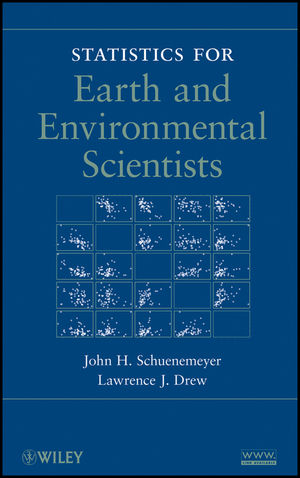Statistics for Earth and Environmental ScientistsISBN: 978-0-470-58469-9
Hardcover
420 pages
February 2011
 This is a Print-on-Demand title. It will be printed specifically to fill your order. Please allow an additional 15-20 days delivery time. The book is not returnable.
|
||||||
1.1 Introduction.
1.2 Case studies.
1.3 Data.
1.4 Samples versus the population, some notation.
1.5 Vector and matrix notation.
1.6 Frequency distributions and histograms
1.7 The distribution as a model.
1.8 Sample moments.
1.9 Normal (Gaussian) distribution.
1.10 Exploratory data analysis.
1.11 Estimation.
1.12 Bias.
1.13 Causes of variance.
1.14 About data.
1.15 Reasons to conduct statistically based studies.
1.16 Data mining.
1.17 Modeling.
1.18 Transformations.
1.19 Statistical concepts.
1.20 Statistics paradigms.
1.21 Summary.
1.22 Exercises.
Chapter 2. Modeling concepts.
2.1 Introduction.
2.2 Why construct a model?
2.3 What does a statistical model do?
2.4 Steps in modeling.
2.5 Is a model a unique solution to a problem?
2.6 Model assumptions.
2.7 Designed experiments.
2.8 Replication.
2.9 Summary.
2.10 Exercises.
Chapter 3. Estimation and hypothesis testing on means and other statistics.
3.1 Introduction.
3.2 Independence of observations.
3.3 The Central Limit Theorem.
3.4 Sampling distributions.
3.4.1 t-distribution.
3.5 Confidence interval estimate on a mean.
3.6 Confidence interval on the difference between means.
3.7 Hypothesis testing on means.
3.8 Bayesian hypothesis testing.
3.9 Nonparametric hypothesis testing.
3.10 Bootstrap hypothesis testing on means.
3.11 Testing multiple means via analysis of variance.
3.12 Multiple comparisons of means.
3.13 Nonparametric ANOVA.
3.14 Paired data.
3.15 Kolmogorov-Smirnov goodness-of-fit test.
3.16 Comments on hypothesis testing.
3.17 Summary.
3.18 Exercises.
Chapter 4. Regression.
4.1 Introduction.
4.2 Pittsburgh coal quality case study.
4.3 Correlation and covariance.
4.4 Simple linear regression.
4.5 Multiple regression.
4.6 Other regression procedures.
4.7 Nonlinear models.
4.8 Summary.
4.9 Exercises.
Chapter 5. Time series.
5.1 Introduction.
5.2 Time Domain.
5.3 Frequency Domain.
5.4 Wavelets.
5.5 Summary.
5.6 Exercises.
Chapter 6. Spatial statistics.
6.1 Introduction.
6.2 Data.
6.3 Three-dimensional data visualization.
6.4 Spatial association.
6.5 The effect of trend.
6.6 Semivariogram models.
6.7 Kriging.
6.8 Space-time models.
6.9 Summary.
6.10 Exercises.
Chapter 7. Multivariate analysis.
7.1 Introduction.
7.2 Multivariate graphics.
7.3 Principal component analysis.
7.4 Factor analysis.
7.5 Cluster analysis.
7.6 Multidimensional scaling.
7.7 Discriminant analysis.
7.8 Tree based modeling.
7.9 Summary.
7.10 Exercises.
Chapter 8. Discrete data analysis and point processes.
8.1 Introduction.
8.2 Discrete process and distributions.
8.3 Point processes.
8.4 Lattice data and models.
8.5 Proportions.
8.6 Contingency tables.
8.7 Generalized linear models.
8.8 Summary.
8.9 Exercises.
Chapter 9 Design of experiments.
9.1 Introduction.
9.2 Sampling designs.
9.3 Design of experiments.
9.4 Comments on field studies and design.
9.5 Missing data.
9.6 Summary.
9.7 Exercises.
Chapter 10 Directional data.
10.1 Introduction.
10.2 Circular data.
10.3 Spherical data.
10.4 Summary.
10.5 Exercises.



